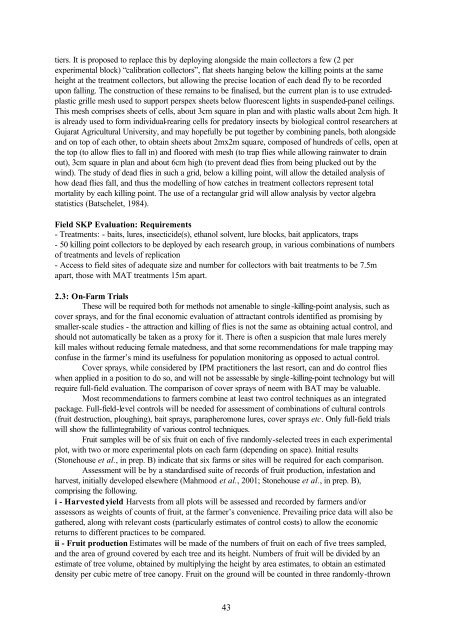“Key Informant Survey” of Production, Value, Losses and ... - DfID
“Key Informant Survey” of Production, Value, Losses and ... - DfID
“Key Informant Survey” of Production, Value, Losses and ... - DfID
You also want an ePaper? Increase the reach of your titles
YUMPU automatically turns print PDFs into web optimized ePapers that Google loves.
tiers. It is proposed to replace this by deploying alongside the main collectors a few (2 per<br />
experimental block) “calibration collectors”, flat sheets hanging below the killing points at the same<br />
height at the treatment collectors, but allowing the precise location <strong>of</strong> each dead fly to be recorded<br />
upon falling. The construction <strong>of</strong> these remains to be finalised, but the current plan is to use extrudedplastic<br />
grille mesh used to support perspex sheets below fluorescent lights in suspended-panel ceilings.<br />
This mesh comprises sheets <strong>of</strong> cells, about 3cm square in plan <strong>and</strong> with plastic walls about 2cm high. It<br />
is already used to form individual-rearing cells for predatory insects by biological control researchers at<br />
Gujarat Agricultural University, <strong>and</strong> may hopefully be put together by combining panels, both alongside<br />
<strong>and</strong> on top <strong>of</strong> each other, to obtain sheets about 2mx2m square, composed <strong>of</strong> hundreds <strong>of</strong> cells, open at<br />
the top (to allow flies to fall in) <strong>and</strong> floored with mesh (to trap flies while allowing rainwater to drain<br />
out), 3cm square in plan <strong>and</strong> about 6cm high (to prevent dead flies from being plucked out by the<br />
wind). The study <strong>of</strong> dead flies in such a grid, below a killing point, will allow the detailed analysis <strong>of</strong><br />
how dead flies fall, <strong>and</strong> thus the modelling <strong>of</strong> how catches in treatment collectors represent total<br />
mortality by each killing point. The use <strong>of</strong> a rectangular grid will allow analysis by vector algebra<br />
statistics (Batschelet, 1984).<br />
Field SKP Evaluation: Requirements<br />
- Treatments: - baits, lures, insecticide(s), ethanol solvent, lure blocks, bait applicators, traps<br />
- 50 killing point collectors to be deployed by each research group, in various combinations <strong>of</strong> numbers<br />
<strong>of</strong> treatments <strong>and</strong> levels <strong>of</strong> replication<br />
- Access to field sites <strong>of</strong> adequate size <strong>and</strong> number for collectors with bait treatments to be 7.5m<br />
apart, those with MAT treatments 15m apart.<br />
2.3: On-Farm Trials<br />
These will be required both for methods not amenable to single-killing-point analysis, such as<br />
cover sprays, <strong>and</strong> for the final economic evaluation <strong>of</strong> attractant controls identified as promising by<br />
smaller-scale studies - the attraction <strong>and</strong> killing <strong>of</strong> flies is not the same as obtaining actual control, <strong>and</strong><br />
should not automatically be taken as a proxy for it. There is <strong>of</strong>ten a suspicion that male lures merely<br />
kill males without reducing female matedness, <strong>and</strong> that some recommendations for male trapping may<br />
confuse in the farmer’s mind its usefulness for population monitoring as opposed to actual control.<br />
Cover sprays, while considered by IPM practitioners the last resort, can <strong>and</strong> do control flies<br />
when applied in a position to do so, <strong>and</strong> will not be assessable by single-killing-point technology but will<br />
require full-field evaluation. The comparison <strong>of</strong> cover sprays <strong>of</strong> neem with BAT may be valuable.<br />
Most recommendations to farmers combine at least two control techniques as an integrated<br />
package. Full-field-level controls will be needed for assessment <strong>of</strong> combinations <strong>of</strong> cultural controls<br />
(fruit destruction, ploughing), bait sprays, parapheromone lures, cover sprays etc. Only full-field trials<br />
will show the fullintegrability <strong>of</strong> various control techniques.<br />
Fruit samples will be <strong>of</strong> six fruit on each <strong>of</strong> five r<strong>and</strong>omly-selected trees in each experimental<br />
plot, with two or more experimental plots on each farm (depending on space). Initial results<br />
(Stonehouse et al., in prep. B) indicate that six farms or sites will be required for each comparison.<br />
Assessment will be by a st<strong>and</strong>ardised suite <strong>of</strong> records <strong>of</strong> fruit production, infestation <strong>and</strong><br />
harvest, initially developed elsewhere (Mahmood et al., 2001; Stonehouse et al., in prep. B),<br />
comprising the following.<br />
i - Harvested yield Harvests from all plots will be assessed <strong>and</strong> recorded by farmers <strong>and</strong>/or<br />
assessors as weights <strong>of</strong> counts <strong>of</strong> fruit, at the farmer’s convenience. Prevailing price data will also be<br />
gathered, along with relevant costs (particularly estimates <strong>of</strong> control costs) to allow the economic<br />
returns to different practices to be compared.<br />
ii - Fruit production Estimates will be made <strong>of</strong> the numbers <strong>of</strong> fruit on each <strong>of</strong> five trees sampled,<br />
<strong>and</strong> the area <strong>of</strong> ground covered by each tree <strong>and</strong> its height. Numbers <strong>of</strong> fruit will be divided by an<br />
estimate <strong>of</strong> tree volume, obtained by multiplying the height by area estimates, to obtain an estimated<br />
density per cubic metre <strong>of</strong> tree canopy. Fruit on the ground will be counted in three r<strong>and</strong>omly-thrown<br />
43

















